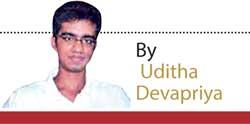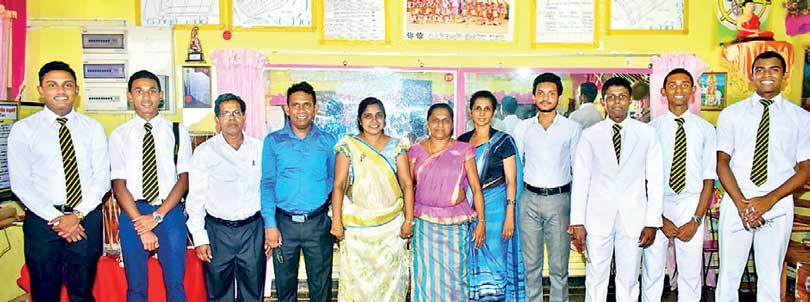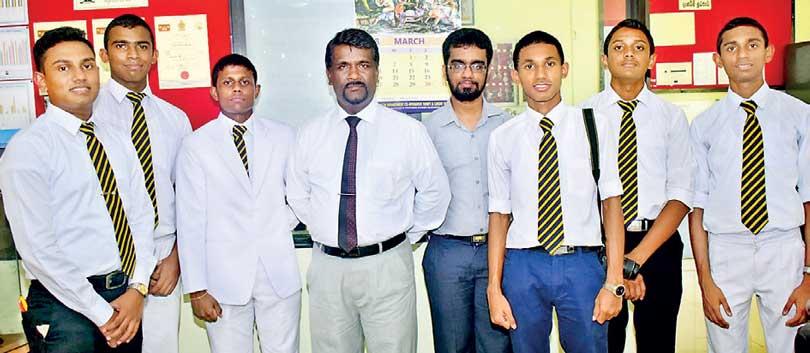Reply To:
Name - Reply Comment

 “What have they planned for us?” the boy next to me asked, bewildered, as the van we all were in drove up past the gates. He got the answer immediately: a procession of students lined up before a budhu medura, boys on one side, girls on the other. It was charming, but perhaps a little too much to take in, since nothing I, or we, had done had warranted a retinue which had obviously been arranged for us. We got down clumsily, some so confused that they’d forgotten to put on their school ties, and stared. Then the bell rang, the principal and the teachers came, and there was a call to worship. Hastily putting our hands together, we obliged and prayed with them.
“What have they planned for us?” the boy next to me asked, bewildered, as the van we all were in drove up past the gates. He got the answer immediately: a procession of students lined up before a budhu medura, boys on one side, girls on the other. It was charming, but perhaps a little too much to take in, since nothing I, or we, had done had warranted a retinue which had obviously been arranged for us. We got down clumsily, some so confused that they’d forgotten to put on their school ties, and stared. Then the bell rang, the principal and the teachers came, and there was a call to worship. Hastily putting our hands together, we obliged and prayed with them.
In most rural Sinhala villages, particularly in far-flung outposts, Buddhism is firmly linked with the education of children. There’s one school in Colombo that’s gained a reputation for its budhu medura, but elsewhere it’s a norm: a school must have a shrine, and students pray before it every morning. For schoolboys from multicultural – and in my case, secular – establishments, it’s hard to come to terms with this reality, because we’re taught a very different gospel in our classrooms. The boys beside me knew their gathas and sutras, certainly more than me, but this kind of communal worship was, I could see, outside their experience: for them faith is personal, never to be invoked out loud. Here, however, one cannot whisper. One has to raise one’s voice.
Through Ratnapura, Rakwana connects Colombo to Embilipitiya, which is where the Sabaragamuwa meets the Dakuna (South). Pelmadulla lies between the two, and we were at present in a school there. To keep a long story short, I had written an article on a set of boys who had organised a Book Fair at their school in Colombo; their leader, who had attended the school we were at until Fifth Grade, had been asked to come with them, and me, to an otherwise innocuous ceremony: the opening of a new library.
Dharmaloka is in that sense an indictment on this dilemma: whereas the big schools have 10 or 15 students studying the subject for their A/Levels, here there are more than 40
It’s a little difficult to explain the sociological undercurrents of this phenomenon: the telescoping of mundane ceremonies to the status of profoundly significant events. But it’s a reality that’s only too pervasive outside Colombo. And in any case, it wasn’t just the library we were occupied with: the boy was being “celebrated” because he’d made it to the news years after he had aced that ultimate symbol of educational mobility, the pahe shishyathwaya (Grade 5 ). We were being celebrated with him, and also thanked for having contributed, in some small way at least, to his ascent.
The school we were at, Dharmaloka Vidyalaya, is not small, but then I realised that this was precisely the point: it’s the kind of intermediate institution which churns out most of the scholarship wallahs who end up at Royal and Ananda and Dharmaraja and Richmond. In this boy and his colleagues, who had also gone to Colombo through the shishyathwaya (scholarship), the staff and the principal had thus vindicated themselves.
Dharmaloka is special, and stands out, for a reason: for the last few years and decades, the school has clinched nearly every category at national art competitions. At last year’s Interschool Art Competition, for instance, 15 of the 16 participants won awards and certificates, coming first in three categories, second in three, and third in one, with two consolation prizes.When it comes to ART or chitra kalawa another problem persists. With each passing generation, fewer and fewer children tend to paint. It’s not just that they don’t want to draw; the truth is that they CAN’T draw. Dharmaloka is in that sense an indictment on this dilemma: whereas the big schools have 10 or 15 students studying the subject for their A/Levels, here there are more than 40. Yet even among the 40 there is an issue: most of them prefer graphic design (mosthara) to expressive art (prakashana); digital commercial art has, sadly, gained over the hand-drawn variety.


Pix by Manusha Lakshan
Gamini Muhandiram, Art teacher at Dharmaloka, cogently highlighted a related problem: “There is an urban-rural gap when it comes to students who settle for this subject. Many of those who select it from these parts of the country do so because they can genuinely draw.
Unfortunately, they don’t have financial strength. We have to provide for them and we have to make up for their shortfalls.” In that sense he feels that State-sponsored art festivals are to be welcomed: “The National Art Competition achieves what it aims at. Among other things, the prize money the students win goes a long way in meeting certain urgent needs.” Not that this solves the problem: the truth remains that the more talented you are, the more indigent you tend to be.
Dharmaloka is special, and stands out, for a reason: for the last few years and decades, the school has clinched nearly every category at national art competitions
Dharmaloka has gone a long way in addressing these issues. If the students have anyone to thank for that, it’s their teacher. And he hasn’t gone unnoticed: last year, for instance, “Gamini sir” won the Teacher of the Year Award at the International Forum for Teachers organised by Gateway Graduate School. There were four other finalists, from Dehiaththakandiya, Galgamuwa, Puttalam and Nuwara Eliya as well.
The author can be reached on [email protected]